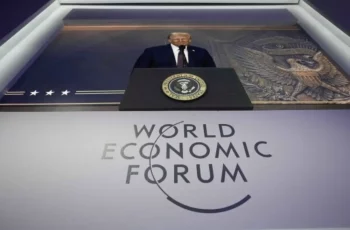
In the run-up to the Jubilee Year, Rome’s authorities have decided to renew the City’s looks: fixing traffic in places of traditional congestion and patching up roadways that have long been in need of repair. And also – otherwise it would be too boring – to charge additional fees from the city’s visitors. It was not without its bribery scandals
The year 2025 is the Jubilee Year in the Catholic Church, the Holy Year of Hope.
The first Jubilee Year took place in 1300 at the wish of Pope Boniface VIII. The Jubilee Year is above all a deeply mystical event for all Catholic faithful, a time when pilgrims seek Rome to pass through the Holy Gates and be spiritually renewed, a time when all sins are absolved, a time of reconciliation between disputants, a time of conversion and sacramental penance.
The name comes from the Hebrew ‘Jobel’ for ‘goat,’ which is related to the ram’s horn used in sacred ceremonies, and echoes the Hebrew ‘Yovel’ for Jubilee, the tradition that every 50 years there was a year in which special laws were in force: the freeing of slaves, the return of land, the cessation of agricultural work.
Boniface VIII originally decreed that the Jubilee should be held every 100 years: during the Holy Year, all Romans who visited the basilicas of St Peter and The Papal Basilica of Saint Paul Outside the Walls fifteen times – thirty if they were Romans – were granted a plenary indulgence for the whole year 1300.
However, in 1350, Pope Clement VI decided to shorten the period to 50 years, as was the case with the Jewish Jubilee, and then Pope Urban VI shortened the period to 33 years. The current term of 25 years was established during the papacy by Paul II (except for ‘extraordinary’ ones, when a Jubilee Year is declared for special reasons).

What will its number be?
The year 2025 will be the 25th regular Ecumenical Jubilee in the history of the Catholic Church.
How many pilgrims are planned to be received?
More than 30 million pilgrims are expected in Rome during the 25th Jubilee Year.
How long will this Jubilee Year last?
The Jubilee Year 2025 will last just over a year, as has been the custom for centuries: from the previous Christmas (25 December 2024) to the next Epiphany (6 January 2026).
Main events
The main event for faithful visitors to the city will be the opening of the Holy Doors in the four main basilicas of Rome, namely St Peter’s, St Paul’s, St John’s and St Maria Maggiore (San Pietro, San Paolo, San Giovanni e Santa Maria Maggiore).
Luce – Symbol of the Jubilee Year

A yellow cloak, mud-stained boots on her feet, a missionary cross around her neck, a pilgrim’s staff in her hands and blue eyes with a shell inside, the symbol of the Pilgrim’s Way in Santiago – this is Luce, the mascot of Jubilee 2025. The author of the mascot, artist Simone Legno, says: “The Jubilee is undoubtedly a unique opportunity to meet and communicate with millions of people, including young people. I hope that Pilgrim Luce and her fellow travellers can personify the sentiments that resonate in the hearts of the younger generations.”
ROME is updating its bow
Indeed 2025 is a critical year for mobility, as Rome receives millions of pilgrims and tourists from all over the world.
Rome’s mayor, Roberto Gualtieri, has repeatedly urged citizens to be patient, realising that numerous construction sites are causing inconvenience. At the end of 2024, only 30 per cent of the 323 projects planned for the Holy Year were in the works.
The cost of some of the ‘important and unrecoverable’ works foreseen by the Prime Minister’s decree of June 2024, entrusted to the Mayor of Rome, Roberto Gualtieri, as the government’s extraordinary commissioner, is rising. And so the first citizen takes his calculator and does the maths again. But in order to increase funds for some works, it is necessary to take them away from others: no new infusion from Palazzo Chigi is foreseen.
The result was 8.67 million euros. As stated in the order of 7 May, signed by Gualtieri, the activity of ‘design, execution of works and calculation of actual costs’ led to the need for a financial reorganisation of the interventions. According to the decree of a year ago, the technicians identified four ‘essential and unquestionable’ objects: the underground in Piazza Pia, the Ponte degli Industria bridge, the cycle path between San Pietro and Monte Chiocci, and the tension structures for the homeless.
In order to ensure sustainable urban traffic management as well as to preserve air quality, the Rome administration has introduced new measures to regulate mobility, including the so-called congestion charge. It will affect the historic centre and the busiest areas, such as the areas around the Vatican, as well as major pilgrimage sites.
In total, taking into account the Jubilee Year funds, the city municipality funds, state funds, as well as funds from Pnrr (Italy’s recovery and resilience plan), the city of Rome was allocated about 3 billion euros.
The Guardia di Finanza (The Guardia di Finanza, or The Financial Police of Italy) conducted searches in Campidoglio (Roma Capitale) as part of the prosecutor’s investigation into the pilot tenders for road repairs and the use of funds for Jubilee 2025. The offences under investigation include bribery, bid-rigging and public procurement fraud in connection with contracts for the repair of roads in the capital.
Roads in Rome repaired with substandard materials
Road repair work was allegedly carried out ‘on the cheap’ by contracting companies to cut costs and get less money, for example on Via della Serenissima, Via della Magliana and Piazzale de Bosis. Poor quality materials were allegedly used to repair the roads or in any case without following the correct, more expensive procedures to ensure that potholes in the asphalt did not reappear, for example to make the road surface thinner.
The Mayor of Rome, Roberto Gualtieri, commented on the corruption investigation into the contracts being carried out by the Financial Guardia and the Public Prosecutor’s Office: “We are following the investigation with the utmost attention, in full co-operation and with a sense of gratitude for the valuable work being done to defend the rule of law, but also with indignation at the possibility of irregularities. What has happened should not overshadow the extraordinary and great work we do.”
For now, pilgrims are staying out of the fray. Visitors to the capital, who also came during the election of the new Pope, note the high organisation of pilgrimage routes and universally praise the ‘Pilgrim Card’ – CARTA DEL PELLEGRINO – a loyalty programme offering discounts to some of the city’s museums.










Comments